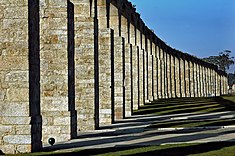Santa Clara Aqueduct
| Aqueduct of Santa Clara (Aqueducto de Santa Clara) | |
| Aqueduct of Vila do Conde | |
| Aqueduct (Aqueducto) | |
|
Vertical pillars of the aqueduct near the Church of Santa Clara
|
|
| Official name: Aqueduto de Vila do Conde/Aqueduto de Santa Clara | |
| Named for: Convent of Santa Clara | |
| Country | |
|---|---|
| Region | Norte |
| Subregion | Grande Porto |
| District | Porto |
| Municipality | Vila do Conde |
| Location | Vila do Conde |
| - coordinates | 41°21′22.7″N 8°44′23.8″W / 41.356306°N 8.739944°WCoordinates: 41°21′22.7″N 8°44′23.8″W / 41.356306°N 8.739944°W |
| Architects | Manuel Pinho Villa Lobos, Domingos Lopes |
| Style | Medieval |
| Material | Granite |
| Origin | 17th century |
| - Initiated | 1626 |
| - Completion | 20 October 1714 |
| Owner | Portuguese Republic |
| For public | Public |
| Easiest access | Vila do Conde, Póvoa de Varzim |
| Management | Instituto Gestão do Patrimonio Arquitectónico e Arqueológico |
| Operator | Câmara Municipal da Vila do Conde |
| Status | National Monument |
| Listing | Decree 16 June 1910; DG136, 23 June 1910; included in the Special Protection Zone of the Church of Santa Clara |
The Aqueduct of Santa Clara is the second largest Portuguese aqueduct system. Built between 1626 and 1714, it includes 999 arches stretching for 4 kilometres (2.5 mi) from the spring of Terroso in the municipality of Póvoa de Varzim to the Convent of Santa Clara in the municipality of Vila do Conde.
Founded at the beginning of the 14th century, the monastic community of Santa Clara always debated the problems with water supply to the monastery in the territory of Vila do Conde. At that time a tank (the arca de água) was constructed within the monastery, which quickly became insufficient to the communities needs. In 1626, the abbey D. Maria de Meneses, from the House of Pentieiros, purchased lands and contracted a master-builder to construct an aqueduct to bring waters from a spring in Terroso, in Póvoa de Varzim, to support the convent. The construction was interrupted by abbey D. Catarina Lima in 1636, owing to the discovery of a significant slope, making the prior work useless.
On 19 December 1705, the project was restarted, under abbess D. Bárbara Micaela de Ataíde, from the House of Honra e Barbosa, in Penafiel. The abbess put the project under the direction of captain Domingos Lopes, from Porto and artillery lieutenant-general Manuel de Villa Lobos. Further support for the project was obtained by D. Bárbara de Ataíde, who (along with sisters D. Maria Ângela and D. Maria António) and brother D. Manuel de Azevedo de Ataíde (Military Governor of the Province of Minho) petitioned the King to provide a private judge and exempt the workers from military service. Although the project was tendered to masterbuilder João Rodrigues (from Ponta de Lima), but failed to complete the project. It was then passed to Domingos Moreira (from Moreira da Maia), who was tasked to complete the project and paid 4400$00 réis.
The first waters reached the convent's cloister on 20 October 1714.
By 2 October 1739, the Congregation of Rites confirmed the excommunication of peoples caught stealing water from the aqueduct.
Somewhere around Casal do Monte, during a storm on 10 June 1794, 46 arches were knocked down.
Between 1929 and 1932, there was an intentional deconstruction of five arches, during the restoration of the Church of Santa Clara, in order to improve the view of the apse.
A tender was issued in January 2004, in order promote the conservation and consolidate the structure.
...
Wikipedia

